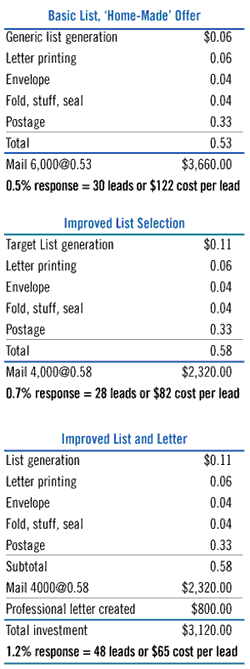
Many readers ofThe Newsfaxed their direct mail letters to me after my article ran in the Oct. 23 issue (“The Do’s and Don’ts of Direct Mail Marketing”). I created some new letters for these readers, but many people asked, “Now, who do I send this to?” Well, that’s the million-dollar question — literally. The greatest direct mail letter in the world is no better than the worst one if it is sent to the wrong list. Both the message and the recipient must be in harmony or the letter fails. A good list is absolutely critical. I hear contractors select lists based on zip codes or customer base only, but they put little additional thought into the process. So they fling out a zillion letters to “anybody” with a letter that is “nowhere” and their results are, predictably, “nothing.” Contractors think they’re saving money by doing all this themselves. They select the list, create the offer, and put it on paper. Yet when you look at the costs and the results, you can see the hopelessly false economy in bad list selection accompanied by a poor letter. Take a look at the example tables. You can see that your cost per lead for the “cheapie” list and “home-made” offer is almost twice as costly per lead than a selected list with a professionally crafted offer. So much for saving money! You should be able to hire a copywriter in your town or through an ad agency who can improve your response rates beyond the example shown. Also, remember that if you get a professionally crafted letter, it’ll be yours to use and this one time charge will not apply on subsequent mailings. So your cost per lead would drop even more thereafter. It just makes good marketing sense. Once you’ve got a great offer, let’s look at selecting a great list to make your job easier and make you more money on your next direct mail offer.
How to Choose A Profitable Mailing List
House list:This is your active list, but it too often is a single heading called “Customers.” Bad idea. Start segmenting lists today with fields for date, dollar amount, job type (service, replacement, IAQ) and system age. You should also have a list of prospects divided among categories. By doing this, you can immediately fire off a letter or postcard to the most likely respondents. You cannot make a better time investment in your marketing.Rented list: From a mailing service or list broker with a variety of “selects,” which refer to your specific list design (zip code, age of home, etc, are all selects). As you’d guess, the more “selects,” the greater the cost per thousand. Try single-family residences, $250,000-plus, over seven years old, within a geographic region. Remember, as the list gets smaller (per select), you save postage and get a better list. Postage is generally the number-one expense.
Geographic list: Also a rented list, but within an area, usually defined by radius to a point or zip code. Cheap, plentiful, but dangerously wasteful in their simplicity unless you’ve got a good reason to stay within a geographic area. (Such as a mass tune-up campaign, open house, etc.) If you want to “own” a neighborhood, this is the list to buy or rent.
CCI list: CCI stands for Champion Circle of Influence; this list uses an “association” to drive the message. A Chamber member, for example, would sign a letter you create that says something like, “As a fellow chamber member, you know how difficult it is to find a business in our town that matches your professional ethics. Yet….” Use neighborhood associations, builders groups, whatever. These lists are underused, yet incredibly powerful.
Reactivation list: Another reason to never throw away names: Inactive or ex-customers will reactivate and spend money — if you say the right things. (Almost no one does. Tragic.) Tell them you miss them, and if you did anything that might’ve offended them, you want to make it right with a free something or discount to “come back into the fold.” We sent 184 excustomers a reactivation letter, and got a 2.6% response for $140,000 in sales. Not bad for money headed to the trash.
Manufacturer-utility list: These may be free! Just ask. Your utility company may also share one other incredible tidbit, average utility bills. Are you thinking what I’m thinking? Get on it.
Partnered list: This is the house list of a noncompetitor (perhaps a plumber who doesn’t do hvac, a maid service, lawn maintenance outfit, or some other company that has a list with shared ideals); in this case, home ownership and maintenance. Your “partner” must introduce you and recommend you in the letter. Clearly, this favor is to be returned, and if appropriate, at zero cost to each.
New homeowners: I’ve written dozens of these letters for contractors, and they’re a great way to introduce your services. The list is good because it’s “fresh,” but be careful that your mailing does not try to stuff a sale on them right away. The theme is simply “welcome,” since they’ve presumably just gone into major debt to become a member of this list. Be soft. It’ll work.
Card deck list-mailing: I intensely dislike these except for one simple reason, they’re very inexpensive. Thus, do not try to sell your high-end stuff here. You’d better be offering a “free” something, a really good finance offer, or a major discount that appeals to the “quick flash” buyer. Otherwise, this is a total waste of money.
FINAL THOUGHTS
Determine “who” is a ready market for “what” message. Then pare down to the most likely respondents.
Next, either write the letter or have one crafted that speaks to them to pull the highest response. You’ll find that effort pays off handsomely.
Hudson is president of Hudson, Ink, whose motto is “Creative Marketing That Works.” He can be reached at 800-489-9099.
Publication date: 11/20/2000




